Exercise 6 :: Rules :: The Dos and Don'ts in a Story World
“Take your shoes off in the house.” “No shoes, no shirts, no service.” “Walk, don’t run.” “Shhh. This is a library.” “Remember your manners.” (In a whisper) “don’t do that, you know it’ll upset mom.”
Rules. They are everywhere. Whether they are spoken, posted, or simply understood, rules govern the way that we as people interact with each other and our world. Rules define what is allowed and what isn’t allowed. In a story world, it governs what can and cannot happen. Some rules are explicit - they are regulations that tell us how to behave. Other rules might be more of a cultural norm - something that you just pick up when you are in a certain culture (we moved to Canada for a few years, and even though nothing really changed - signs were in English, people looked just like the people on the other side of the border, stores were even the same - there was a discernible difference, and we quickly picked up on the cultural “rules” that made us realize we were in a different place).
Our definition of rules - “rules govern behavior within the story world” - contains an important word - governs. Rules provide the framework and boundaries of behavior. So, for example, if you set a story in space, there should be certain things that govern behavior - lack of gravity will “govern” how objects are handled and people move around. If your story is set in the wild west, there are definitely other rules that will govern behavior. If your story has a fantasy element, like the CS Lewis stories about Narnia, then there are very specific rules - the animals that are in Narnia can talk. Time is different in Narnia than in England. If you eat enchanted Turkish delight in Narnia, certain things will happen. Each of these rules must be followed (if one of the animals in England started talking, it would pull the reader out of the story and no longer feel like a real story) or the story world isn’t as complete or whole. If the rule isn’t followed (I recall some animals in Narnia who couldn’t talk), it should prompt the reader to ask why and look for the meaning behind that. Ask your student to think of their favorite story (book, movie, even video game). Ask a few questions about the story world - what is allowed and what isn’t? What about its setting (location/time/event) or values dictates that certain things can or can’t happen? What behaviors that happen in this world cannot happen in ours?
So, why are rules so important to story? They keep it real and unified. Think of a young child. In your home, they are not allowed to jump on the beds. But they go to a friend’s house, and everyone is jumping on the bed and they feel uncomfortable - “rules” are being broken. There is discord for them. When this happens in story, for example someone in a story about the gold rush era pulls out a cell phone to make a call, there is discord, and the story is broken for the reader. Creating and abiding by the rules of a story world is particularly important in fantasy, where anything could happen, but not everything should happen! More on this in another article. For now, help your child see rules in their own world, and help them to define the rules when they create their own story world.
In Real Life :: I encourage you to ask these kinds of questions throughout your week. When you are at the grocery store, what “rules” are there that you as a family follow? When you are watching a movie, what rules can you detect, and how do they affect the actions of the characters? When your kids are playing together, what rules do they naturally develop between them? When they run too quickly in the hallway and slip and fall, what rules have they broken? Don’t be afraid to point these things out to your child, and help them see that rules are everywhere, even when they are not explicitly rules.
Finding it in the Story :: One boring one is that the story is always italicized, while the exercises are not. This “rule” allows the student to know when they are in the story and when they are, technically, learning. (In a fiction book, this might look like the characters thoughts being italicized, while what’s spoken or understood by all to be regular type). Another obvious one is that you don’t disobey the Captain. But here’s one that’s more subtle, and can help them see how rules govern the story world - Captain LeFossa has TWO wooden legs. How can he walk? The book doesn’t ever address this (though Scurvy Spat mentions his wonder about it on page 66), but it is a “rule” in this story that the Captain can walk, jump, run, and defeat kraken with two wooden legs. It’s a silly rule, but allows the story to function and governs how the Captain can behave. Another subtle “rule” to the story is that all the locations are weird variations of normal places (Gran Brintian instead of Great Britain).
